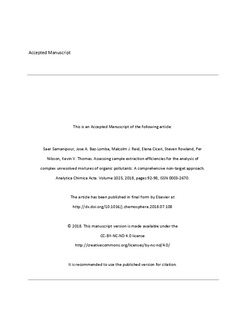| dc.contributor.author | Samanipour, Saer | |
| dc.contributor.author | Baz-Lomba, Jose A | |
| dc.contributor.author | Reid, Malcolm J | |
| dc.contributor.author | Ciceri, Elena | |
| dc.contributor.author | Rowland, Steven | |
| dc.contributor.author | Nilsson, Per | |
| dc.contributor.author | Thomas, Kevin V | |
| dc.date.accessioned | 2019-06-03T07:37:36Z | |
| dc.date.available | 2019-06-03T07:37:36Z | |
| dc.date.created | 2018-12-16T20:08:49Z | |
| dc.date.issued | 2018 | |
| dc.identifier.citation | Analytica Chimica Acta. 2018, 1025, 92-98. | nb_NO |
| dc.identifier.issn | 0003-2670 | |
| dc.identifier.uri | http://hdl.handle.net/11250/2599613 | |
| dc.description.abstract | The comprehensive extraction recovery assessment of organic analytes from complex samples such as oil field produced water (PW) is a challenging task. A targeted approach is usually used for recovery and determination of compounds in these types of analysis. Here we suggest a more comprehensive and less biased approach for the extraction recovery assessment of complex samples. This method combines conventional targeted analysis with a non-targeted approach to evaluate the extraction recovery of complex mixtures. Three generic extraction methods: liquid-liquid extraction (Lq), and solid phase extraction using HLB cartridges (HLB), and the combination of ENV+ and C8 (ENV) cartridges, were selected for evaluation. PW was divided into three parts: non-spiked, spiked level 1, and spiked level 2 for analysis. The spiked samples were used for targeted evaluation of extraction recoveries of 65 added target analytes comprising alkanes, phenols, and polycyclic aromatic hydrocarbons, producing absolute recoveries. The non-spiked samples were used for the non-targeted approach, which used a combination of the F-ratio method and apex detection algorithm. Targeted analysis showed that the use of ENV cartridges and the Lq method performed better than use of HLB cartridges, producing absolute recoveries of 53.1 ± 15.2 for ENV and 46.8 ± 13.2 for Lq versus 19.7 ± 6.7 for HLB. These two methods appeared to produce statistically similar results for recoveries of analytes, whereas they were both different from the produced recoveries via the HLB method. The non-targeted approach captured unique features that were specific to each extraction method. This approach generated 26 unique features (mass spectral ions), which were significantly different between samples and were relevant in differentiating each extract from each method. Using a combination of these targeted and non-targeted methods we evaluated the extraction recoveries of the three extraction methods for analysis of PW. | nb_NO |
| dc.language.iso | eng | nb_NO |
| dc.publisher | Elsevier | nb_NO |
| dc.rights | Attribution-NonCommercial-NoDerivatives 4.0 Internasjonal | * |
| dc.rights.uri | http://creativecommons.org/licenses/by-nc-nd/4.0/deed.no | * |
| dc.title | Assessing sample extraction efficiencies for the analysis of complex unresolved mixtures of organic pollutants: A comprehensive non-target approach | nb_NO |
| dc.type | Journal article | nb_NO |
| dc.type | Peer reviewed | nb_NO |
| dc.description.version | acceptedVersion | nb_NO |
| dc.rights.holder | © 2018 Elsevier | nb_NO |
| dc.source.pagenumber | 92-98 | nb_NO |
| dc.source.volume | 1025 | nb_NO |
| dc.source.journal | Analytica Chimica Acta | nb_NO |
| dc.identifier.doi | 10.1016/j.aca.2018.04.020 | |
| dc.identifier.cristin | 1643767 | |
| dc.relation.project | Norges forskningsråd: 243720 | nb_NO |
| cristin.unitcode | 7464,30,21,0 | |
| cristin.unitname | Miljøkjemi | |
| cristin.ispublished | true | |
| cristin.fulltext | postprint | |
| cristin.qualitycode | 1 | |

